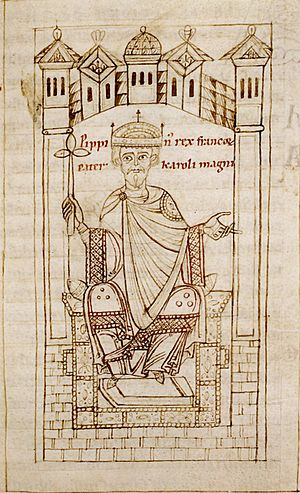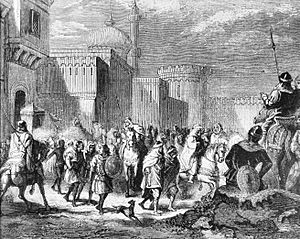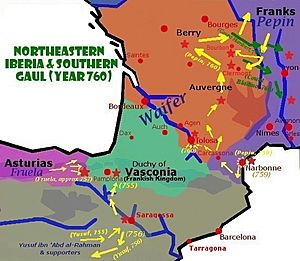Pepin the Short facts for kids
Quick facts for kids Pepin the Short |
|
|---|---|

Pepin the Younger, miniature, Anonymi chronica imperatorum, c. 1112–1114
|
|
| King of the Franks | |
| Reign | 751 – 24 September 768 |
| Predecessor | Childeric III |
| Successor | Charlemagne and Carloman I |
| Mayor of the Palace of Neustria | |
| Reign | 741–751 |
| Predecessor | Charles Martel |
| Successor | Charlemagne |
| Mayor of the Palace of Austrasia | |
| Reign | 747–751 |
| Predecessor | Carloman |
| Successor | Merged into crown |
| Born | c. 714 |
| Died | 24 September 768 (aged 53–54) Saint-Denis, Kingdom of the Franks |
| Burial | Basilica of St Denis |
| Spouse | Bertrada of Laon |
| Issue | Charlemagne Carloman I Gisela |
| Dynasty | Carolingian |
| Father | Charles Martel |
| Mother | Rotrude of Hesbaye |
| Religion | Chalcedonian Christianity |
| Signature | |
Pepin the Short (born around 714 – died September 24, 768) was a very important king of the Franks. He was the first king from the Carolingian dynasty. His name is sometimes spelled Pippin.
Pepin was the son of Charles Martel, a powerful Frankish leader. His mother was Rotrude of Hesbaye. Pepin grew up learning from Christian monks near Paris. This education made him friendly towards the Christian Church and the Pope.
In 741, Pepin became the Mayor of the Palace. This was a powerful job, almost like a prime minister. He ruled alongside his older brother, Carloman. Pepin ruled areas like Neustria, Burgundy, and Provence. Carloman ruled Austrasia and other regions.
The brothers worked to stop revolts from groups like the Bavarians and Saxons. In 743, they chose Childeric III to be the King of the Franks. Childeric was the last king from the old Merovingian dynasty. But he was just a figurehead, meaning he had the title but no real power.
Contents
How Pepin Became King
Pepin's brother Carloman was a very religious man. In 747, Carloman decided to become a monk. This left Pepin as the only ruler of the Franks. Pepin then stopped a revolt led by his half-brother, Grifo. This made Pepin the clear leader of all Francia.
Pepin wanted to be the official king, not just the Mayor of the Palace. He asked Pope Zachary a question: "Is it right for the kings of the Franks to have no royal power?" The Pope agreed that the person with real power should be the king.
So, in 751, Childeric III was removed from the throne and sent to a monastery. Then, Frankish nobles chose Pepin as their new king. This was a huge change!
Pepin's Coronation

Pepin was first crowned in 751 in Soissons. Later, in 754, Pope Stephen II traveled to Paris. He crowned Pepin again in a special ceremony. This was the first time a Pope had crowned a ruler. The Pope also gave Pepin and his sons, Charles (who became Charlemagne) and Carloman, the title Patrician of Rome. This title meant Pepin was seen as the protector of the Church.
The Pope also said that only people from Pepin's family could be elected king in the future. This helped make the Carolingian family very powerful.
Expanding the Frankish Kingdom
As king, Pepin worked to make his kingdom bigger and stronger. He changed Frankish laws and continued to reform the Church.
Wars with the Lombards
Pepin helped the Pope against the Lombards in Italy. The Lombards were taking land from the Church. Pepin forced the Lombard king to give back the land. This land, including cities like Ravenna, was given to the Pope. This gift is known as the Donation of Pepin. It created the Papal States, which were lands ruled by the Pope.
Conquering New Lands

Pepin also fought to expand his kingdom to the south. He conquered Septimania from the Muslims. He besieged the city of Narbonne for seven years, finally capturing it in 759. This pushed the Muslims out of what is now France.
Pepin also fought against Waiofar, the Duke of Aquitaine. This was a long and difficult war. Pepin used harsh tactics, burning towns and destroying farms. By 765, he had largely defeated the resistance in Aquitaine. He captured important cities like Toulouse and Bordeaux. Waiofar was eventually killed by his own followers in 768.
Pepin also fought against the Saxons and Bavarians. He campaigned in Germania, but his sons finished conquering these tribes.
Pepin's Legacy
Pepin the Short died in 768, at 54 years old. He was buried in the Basilica of St Denis in modern-day Paris. His wife, Bertrada of Laon, was also buried there.
Pepin's kingdom was divided between his two sons, Charlemagne and Carloman I.
Even though his son Charlemagne became more famous, Pepin was a very successful ruler. He built up the Frankish army, especially its heavy cavalry. He kept a standing army to protect the kingdom. He not only stopped the Muslims but drove them out of France. He also brought the Aquitanians under Frankish control after many years of fighting.
Pepin's rule was very important for the Franks. He made the Carolingian family the main ruling family in Europe. He was a great conqueror and was never defeated in battle.
Family Life
Pepin first married Leutberga and had five children. She was later sent away, and her children went to convents.
In 741, Pepin married Bertrada of Laon. They had eight children, and at least three lived to be adults:
- Charles (born 742 – died 814)
- Carloman (born 751 – died 771)
- Pepin (born 756 – died 762)
- Gisela (born 757 – died 810)
- Berthe, who died young
- Adelais, who died young
- Chrothais, who died young
Images for kids
-
Coronation in 751 of Pepin by Boniface, Archbishop of Mainz
-
Muslim troops leaving Narbonne in 759, after 40 years of occupation
See also
 In Spanish: Pipino el Breve para niños
In Spanish: Pipino el Breve para niños







